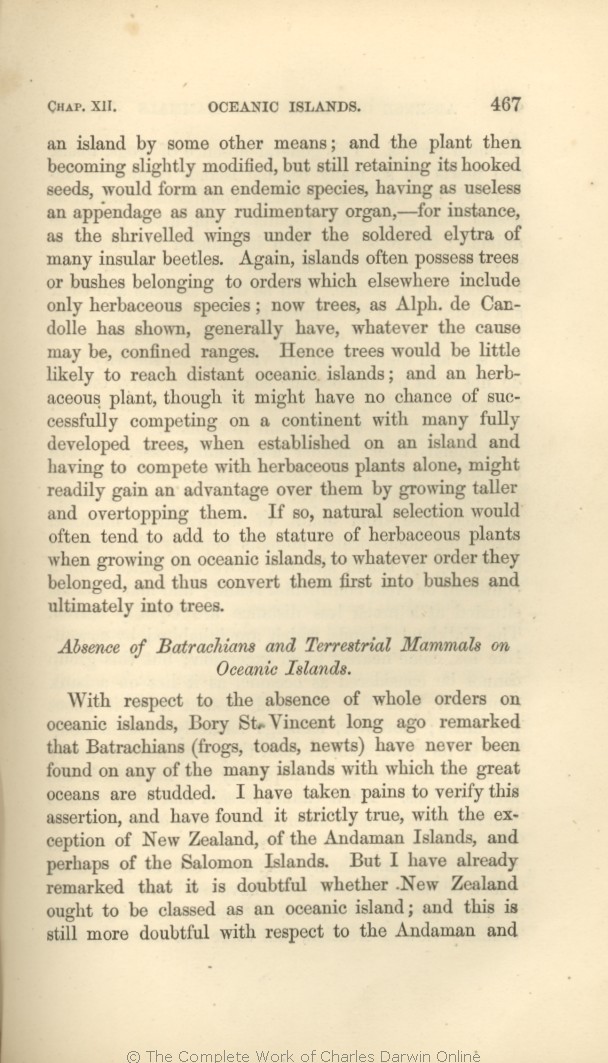an island by
some | some 1859 1860 1861 1866 | some 1869 1872 |
| slightly 1859 1860 1861 1866 | slightly 1869 1872 |
| modified, 1859 1860 1861 1866 | | modified 1869 1872 |
| but still retaining its hooked seeds, 1859 1860 1861 1866 |
| OMIT 1869 1872 |
| having as useless an appendage as any rudimentary organ,— for instance, as 1859 1860 1861 1866 |
| which might still retain the hooks, which would not form a more useless appendage than 1869 |
| still retaining its hooks, which would form a useless appendage like 1872 |
| elytra 1859 1860 1861 1866 1869 | | wing-covers 1872 |
| which 1859 1860 1861 1866 1872 | which 1869 |
| include 1859 1860 1861 1866 1872 | | including 1869 |
| whatever 1859 1860 1861 1866 1872 | | what- ever 1869 |
| be 1859 1860 1861 1866 1872 | | he 1869 |
| though it might have 1866 |
| though it would have 1859 1860 1861 |
| which had 1869 1872 |
| successfully 1859 1860 1866 1869 1872 | | suc- cessfully 1861 |
| on a continent with many 1866 |
| in stature with a 1859 1860 1861 |
| with the many 1869 1872 |
| trees, 1866 | | tree, 1859 1860 1861 | | trees 1869 1872 |
| when 1859 1860 1861 1866 |
| growing on a continent, might, when 1869 1872 |
| island 1859 1860 1861 1866 | | island, 1869 1872 |
| and having to compete with herbaceous plants alone, might readily gain an advantage 1859 1860 1861 1866 |
| gain an advantage 1869 |
| gain an advantage over other herbaceous plants 1872 |
| over them by 1866 |
| by 1859 1860 1861 1869 1872 |
| overtopping them. 1866 |
| taller and overtopping the other plants. 1859 1860 1861 |
| taller and overtopping the other herbaceous plants. 1869 |
| taller and overtopping them. 1872 |
| If so, 1859 1860 1861 1866 |
| In this case, 1869 1872 |
| often 1859 1860 1861 1866 | often 1869 1872 |
| herbaceous 1859 1860 1861 1866 | | the 1869 1872 |
| plants 1859 1860 1861 1866 | | plant, 1869 1872 |
| when growing on oceanic islands, 1866 |
| when growing on an island, 1859 |
| when growing on an oceanic island, 1860 1861 |
| OMIT 1869 1872 |
| they 1859 1860 1861 1866 | | it 1869 1872 |
| convert them first into bushes and ultimately into 1859 1860 1861 1866 |
| convert it first into a bush and then into a 1869 |
| first convert it into a bush and then into a 1872 |
| trees. 1859 1860 1861 1866 | | tree. 1869 1872 |
|
With respect to the absence of whole orders
on | on 1859 1860 1861 1866 |
| of animals on 1869 1872 |
| have 1859 1860 1861 1866 | | are 1869 1872 |
| been 1859 1860 1861 1866 | been 1869 1872 |
| ..... 1866 1869 1872 | | I 1859 1860 1861 |
| strictly 1859 1860 1861 1866 1869 | strictly 1872 |
| true, with the exception of New Zealand, of the Andaman Islands, and perhaps of the Salomon Islands. 1866 1869 |
| true. 1859 1860 1861 |
| true, with the exception of New Zealand, New Caledonia, the Andaman Islands, and perhaps the Salomon Islands and the Seychelles. 1872 |
| But I have already remarked that it is doubtful whether 1866 |
| I have, however, been assured that a frog exists on the mountains of the great island of 1859 1860 1861 |
| Zealand 1866 | | Zealand; 1859 1860 1861 |
| ought to be classed as an oceanic island; and this is still more doubtful with respect to the Andaman and Salomon groups. 1866 |
| but I suspect that this exception (if the information be correct) may be explained through glacial agency. 1859 1860 1861 |
|









